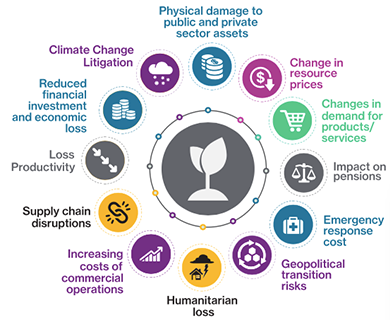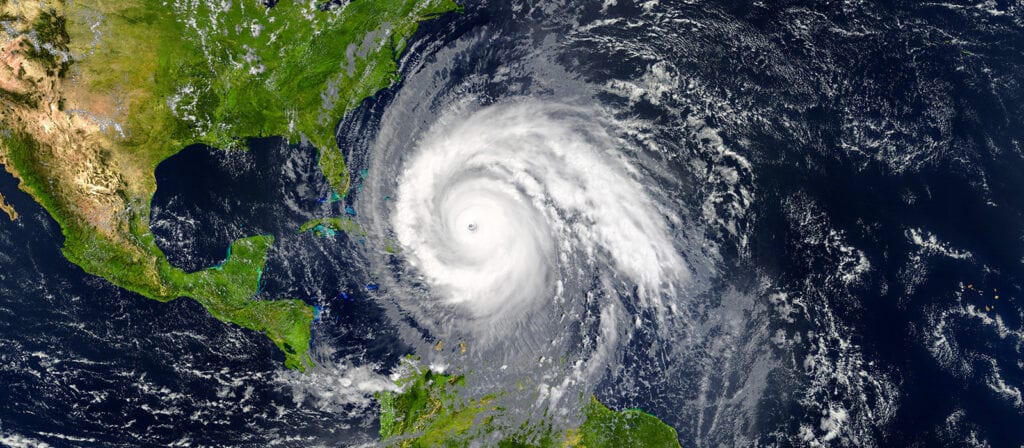Insurers typically face a steep learning curve in embedding climate risk into their Enterprise Risk Management (ERM) programmes, but the climb will be worth it. Taking a strategic approach to the impacts of climate change will put insurers in a position to deal more effectively with the threats and embrace the opportunities of a future low carbon economy .
Insurers are not big polluters in their own right. Nor do they typically have lots of physical assets at risk, except indirectly through investment portfolios either now or in the future when economic transition raises the possibility of stranded assets.
Yet the impacts of climate on insurance operations are only too evident. Losses from more frequent flood events and other climate-related events, such as the wildfires that have ravaged parts of the U.S. and Australia in recent months; changing attitudes towards insuring and investing in high carbon industries; burgeoning regulation and moves towards mandatory climate risk disclosure; and external ESG (Environmental, Social, Governance) ratings that increasingly reflect assessments of climate risk management - are all changing insurers’ risk landscapes.
With the PRA letter to UK insurers also setting the expectation that “firms should have fully embedded their approaches to managing climate-related financial risks by the end of 2021”, it’s relatively unsurprising then that climate change has been rising rapidly up the rankings of the perceived most dangerous risks to an insurance enterprise. In the most recent Willis Towers Watson Dangerous Risks Survey for example, climate change rose from 53rd position in 2019 to 9th in 2020.
On the other hand, up-side risks should not be ignored: climate risk also brings new insurable opportunities and insurance can often be an enabler of innovation, allowing new technologies to be developed as risks are shared. Insurers that are taking steps now to better understand the risks and opportunities and planning for changes in their mid- to long-term strategies will be better placed to deal with them in the future. They will have built up a body of data, tools, analytical capabilities, processes and frameworks, with experience of ongoing learning and refinement, to avoid having to play catch up with the rapidly evolving regulatory environment as our collective knowledge of climate impacts grows.
Climate risk is truly multi-dimensional
Much as loss events grab the headlines, climate risk for insurers is truly multi-dimensional (see below). Potential ramifications that may not be grabbing the headlines yet could have potentially devastating consequences in years to come, such as sea level rise or threats that destabilise fragile states. Equally, new pathways for mitigating climate risk and resilience that don’t exist now could offer respite from threats and open up new business opportunities.
The need for a multi-dimensional risk approach simply reflects this expanding diversity of climate risk drivers.



This article was written by Hélène Galy, Managing Director, Willis Research Network; Lucy Stanbrough, Emerging Risks Research Manager, Willis Research Network; and Adhiraj Maitra, Director, Insurance Climate Risk, Willis Towers Watson, and is part of its Insurer Solutions Climate Risk Series. The article is reproduced with the kind permission of ICMIF Supporting Member Willis Re.
Even if we confine those to the current day, from one angle there are market factors, such as regulation and investors’ lengthening ESG agendas. From another, there is the societal pressure to consume less and reduce environmental impact. Then there is the role of science and advances in climate understanding and adaptation, together with mitigation technologies, and what these tell us about the need to adapt collective behaviour. Notably, many of the world’s central banks and supervisors, through the Network for Greening the Financial System (NGFS), have already upgraded their view on the financial risks from climate change. The risks from climate change are now increasingly seen as having ‘distinct characteristics’ which means these risks need to be ‘considered and managed differently’.
The potential impacts on operations are similarly diverse, not the least whether factors such as public policy and regulation may affect insurability of certain segments. Add in underwriting issues (risk assessment; pricing sufficiency/competitiveness), regulatory compliance (including solvency impact), capital considerations (risk accumulation for example), and emerging risks (and opportunities) – and you have a veritable cocktail of risk dimensions to consider.
ERM implications
In many ways, however, these risks are not new per se; they map onto existing categories of financial and non-financial risk such as credit, market, business, operation and legal risks that insurers have been managing for many years. But taking into account the vagaries of climate, they do present new challenges.
Specifically for ERM programmes, they raise issues and questions that require explicit consideration.
- Governance, including the board’s role in providing oversight of climate risk responses and defining management responsibility for climate risk and ESG integration.
- Risk identification, identifying the key channels through which climate risks can impact the company and how these are articulated and monitored on an ongoing basis.
- Risk appetite, including forming a view as to whether climate risk should be considered as a separate element or part of aggregate risk and how this will be implemented in practice.
- Risk measurement and reporting, including how to incorporate climate risk into financial risk models and reports and deciding on relevant metrics for decision making, a key element of Taskforce for Climate-related Financial Disclosure (TCFD) requirements, for example.
- Investment – how does the investment approach meet ESG objectives and respond to investor pressure to reduce or eliminate funding of high carbon industries, for example?
- Reputation risk, including identifying public communications needs and a strategy for communicating a firm’s climate and ESG response.
And since all in turn, feed through to strategic business considerations such as earnings, product development, long-term direction and acquisitions and divestments, having a solid understanding within the business of the interconnections between physical, transition and liability risks is increasingly essential. This also means that the risk and governance frameworks need to be holistic and each aspect cannot be treated in isolation.
Devil is in the detail
Conceptually, this all probably makes sense. Where it starts to get more tricky is getting into the long weeds of risk impact and mitigation. For that, quantification is key.
This needs proven analytics tools and methods that are constantly being refreshed to reflect the latest science, predictive climate change scenario datasets, and the expertise to provide the context of how business decisions can impact potential futures. Typically, it will also entail a collective, systematic and open data collection initiative to capture appropriate data to represent the key risk-related attributes of assets, and equally importantly, to include the valuations needed to feed through into balance sheet and other decision-making views.
Examples of the types of outputs needed will include hazard and climate risk scoring and mapping, determination of hazard and climate-adjusted financial losses and advanced modelling of current and future climate risks. And beyond the numbers, transparency of models, scenarios and parameters is also key to the credibility and flexibility of the approach.
Our view is that there are some key analytical building blocks in helping build understanding of climate risk. Even if these may represent a kind of analytical nirvana at the moment, principally due to lack of data, there are options. Drawing parallels with emerging cyber risk, many insurers relied on scenario analysis and a risk disclosure statement type approach to not only quantify risks but also set risk appetite metrics:
- Identify hazards – review of the existing portfolio for exposure to climate and natural catastrophe perils to establish the hazard levels.
- Quantify current climate risk for key perils – modelling of the current portfolio of risks, taking into account the vulnerability of assets and the level of hazard with reference to past events.
- Quantify future climate risk for key perils – modelling of future portfolios of risks for key perils at different time periods (e.g. 2030, 2050) and climate development scenarios. This should also consider the interconnectedness between perils – compounding and cascading risks are difficult to model, but they are the real world.
- Climate risk mitigation opportunities – identification and assessment of loss drivers and mitigation opportunities to help reduce the financial loss potential of climate change.
- Determine transition risk and opportunities – evaluation of potential transition routes in line with modelling and taking steps to embed them within the risk framework.
- Quantify transition risks – through breakdown of the top transition risks by region/climate scenarios.
As they become armed with this sort of information, insurers should be able to identify the regions and perils which are driving climate risk now and how this distribution could change in the future. Critically, it will help to quantify and reduce the cost of climate risk and enable insurers to feed the results into reviewing and updating the risk appetite and management frameworks on a regular basis.
Given the evolving investment focus on the ‘social contract’ and sustainable returns, it will also be increasingly important for being able to inform potential investors of both the impact of climate change on an organisation and steps being taken by the business to reduce its climate impact.
This need has been further accelerated by recent regulatory moves focused around reporting and disclosure, including proposals and consultations in some countries to make TCFD reporting mandatory sooner rather than later. Add to this the idea that COVID-19 may accelerate the broader appetite for ESG as financial markets look to build resilience to systemic risks, and there is an even stronger case for enhancing understanding and response.
The upside is that the positive reputational impacts of disclosure, enforced or otherwise, are likely to be more far-reaching than just compliance – working through this process provides a holistic stress test of strategic decision making and company direction.
Eye to the future
So where might the gaps lie? To be truly strategic, thinking about climate risk needs to properly address current climate risks, and project five, 10, and 20 years into the future at least. That means developing the climate trajectory scenarios and metrics (the areas incidentally where insurers say they expect to need most help according to our TCFD survey) that are increasingly being demanded by various stakeholders in order to make an assessment of a company’s climate transition plans and contribution.
Not all companies will be equally affected, but it’s apparent that, in relatively quick time, climate will have to be a central component of ERM and strategic direction. Those running ERM programmes at insurers are uniquely placed to ensure their companies are prepared to meet those rising and multi-faceted expectations of investors, regulators, employees, customers, and other stakeholders.
Embedding climate risk into existing frameworks and ensuring Boards are taking a strategic approach to the changes that are already happening, and those to come, will put companies in a position to deal more effectively with the threats and embrace the opportunities of a future low carbon economy.





